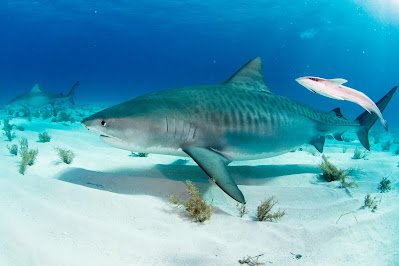Every 29 July, the world observes International Tiger Shark Day to raise awareness about the importance of tiger sharks in marine ecosystems, address misconceptions about sharks, and advocate for shark conservation globally.
Tiger sharks (Galeocerdo cuvier) are named for the dark stripes on their bodies and are vital apex predators in maintaining the balance of ocean ecosystems.
🦈 Why International Tiger Shark Day Matters
✅ Apex Predators: Tiger sharks help regulate marine species populations, ensuring healthy oceans.
✅ Vulnerable Species: Classified as Near Threatened on the IUCN Red List due to overfishing and bycatch.
✅ Misunderstood Creatures: Often unfairly portrayed as aggressive, leading to unnecessary culling.
✅ Ocean Health Indicators: Protecting tiger sharks also safeguards coral reefs and marine biodiversity.
🌟 2025 Theme
The 2025 theme for International Tiger Shark Day is:
“Protect the Stripes: Preserve Our Oceans.”
This theme emphasizes the urgency of reducing bycatch, ending shark finning, and establishing marine protected areas for tiger sharks and marine life.
📊 Key Facts
✨ Tiger sharks are found in tropical and temperate waters worldwide, often near coastlines and coral reefs.
✨ They can grow up to 5 meters (16 feet) and live for 27–50 years.
✨ Tiger sharks are essential in controlling prey populations, including sea turtles and rays.
✨ Millions of sharks are killed annually due to bycatch, finning, and culling, threatening marine balance.
🎉 How to Observe International Tiger Shark Day
✅ Learn & Share: Spread accurate information about tiger sharks using #InternationalTigerSharkDay.
✅ Support Conservation: Donate to shark conservation organizations such as Shark Trust and Shark Allies.
✅ Reduce Plastic Use: Plastic pollution harms marine life, including sharks.
✅ Watch Documentaries: Films like “Sharkwater” and “Tigers of the Deep” highlight shark conservation issues.
✅ Advocate: Push for policies banning shark finning and supporting sustainable fishing.
💡 Why It Matters
✅ Sharks help maintain healthy fish populations, supporting the marine food web.
✅ Conserving sharks protects coral reefs and coastal ecosystems, contributing to climate resilience.
✅ A healthy shark population supports the ocean economy, including eco-tourism and fisheries balance.
“Sharks are the guardians of the ocean. Without them, the ocean’s health collapses.”
🌊 Artistic & Educational Opportunities
For artists and educators:
🎨 Create tiger shark-themed illustrations or ocean conservation art for your audience.
📸 Share underwater photography or documentaries on sharks.
🖋️ Write reflective pieces on the beauty and necessity of sharks in marine ecosystems.
📌 Final Thought
On 29 July, let International Tiger Shark Day remind us to protect these vital guardians of our oceans, ensuring a thriving marine world for generations to come.
🏠 For more art, travel, and cultural stories, visit our CRA ARTS Main Page.

Comments
Post a Comment